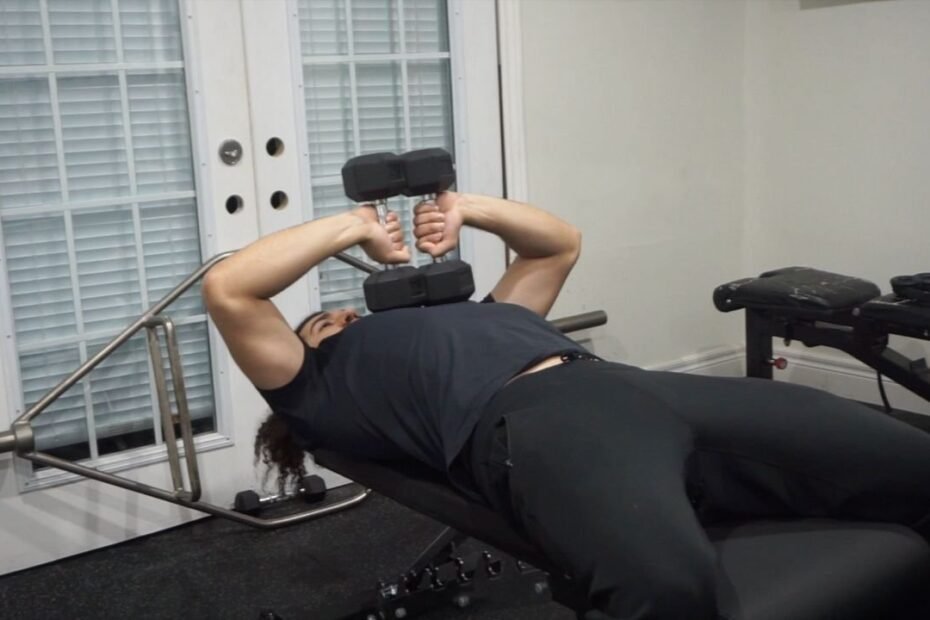The dumbbell Tate press, also known as the dumbbell elbow extension, is a highly effective exercise specifically designed to target the triceps brachii muscles. This comprehensive guide covers the muscles engaged, proper technique, benefits, safety considerations, alternative exercises, variations, and common mistakes associated with the dumbbell Tate press.
Muscles Worked:
- Primary Muscle: Triceps Brachii
How to Perform the Dumbbell Tate Press:
Follow these steps to execute the dumbbell Tate press with proper form:

- Starting Position: Lie on a bench with your feet planted firmly on the floor. Grasp a dumbbell in each hand, positioning them directly above your chest. Ensure your palms are facing each other.
- Elbow Bend and Rotation: Gradually lower the dumbbells towards your chest by bending your elbows. While descending, rotate your wrists so that your palms face your feet.
- Elbow Extension: Initiate the upward phase by extending your elbows. Throughout this motion, maintain the wrist rotation and concentrate on contracting your triceps muscles at the peak of the movement.
- Reversal of Motion: Gradually bend your elbows once more, reversing the wrist rotation as you bring the dumbbells back to the starting position at chest level.
- Repeat the Movement: Perform the desired number of repetitions while maintaining steady control over the weights throughout the entire range of motion.
Benefits:
Incorporating the dumbbell Tate press into your workout routine offers numerous benefits:
- Triceps Isolation: This exercise effectively targets and isolates the triceps, leading to improved strength and enhanced muscle definition.
- Unique Angle: The wrist rotation involved in this exercise activates the triceps from a distinct angle, contributing to a well-rounded triceps workout.
- Functional Strength: Strong triceps are essential for various pushing movements in both everyday activities and fitness endeavors.
Safety Tips:
To ensure safe and effective execution of the dumbbell Tate press, keep these tips in mind:
- Select a dumbbell weight that permits you to complete the desired repetitions with proper form.
- Maintain consistent wrist rotation throughout the entire movement to optimize triceps engagement.
- Execute controlled and steady motions, refraining from sudden jerks or swinging.
- If any discomfort or pain arises, discontinue the exercise and consult a fitness professional or healthcare provider.
Alternative Exercises:
If you’re seeking to diversify your triceps workout, consider these alternative exercises:
- Close-Grip Bench Press: A compound movement that engages the triceps alongside the chest and shoulders.
- Skull Crushers: Also known as lying triceps extensions, this exercise effectively targets the triceps.
Variations:
Add variety to your regimen with these variations of the dumbbell Tate press:
- Single-Arm Tate Press: Perform the exercise one arm at a time to concentrate on each triceps muscle independently.
- Seated Dumbbell Tate Press: Execute the Tate press while seated on a bench to enhance stability.
Common Mistakes:
Avoid these common mistakes to ensure effective and safe execution of the dumbbell Tate press:
- Excessive Weight: Choose a weight that allows you to sustain proper form and complete the desired repetitions.
- Wrist Rotation Neglect: Ensure consistent wrist rotation to activate the triceps optimally.
- Lack of Control: Maintain control over the dumbbells throughout the exercise to minimize the risk of injury.
Integrate the dumbbell Tate press into your triceps-focused workout routine to elevate triceps strength, definition, and overall arm aesthetics. Prioritize impeccable form, controlled movements, and gradual progression in both weight and repetitions. If you possess any pre-existing health concerns or injuries, it’s advisable to consult fitness professionals or healthcare providers before incorporating this exercise into your fitness plan.
